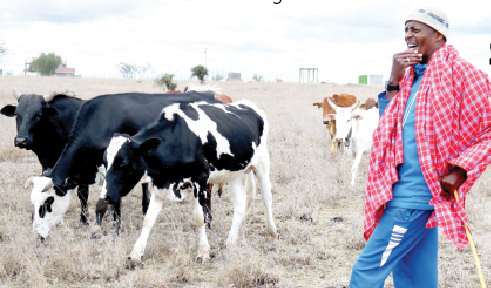Is our love for meat and milk hurting the environment?

As heavy drops of rain begin to pound the grass-covered farm in Kajiado county, a cacophony of bleats, moos and cowbells rents the air. It’s midmorning and Teto Ole Tutuma, a livestock farmer, is rushing to drive his sheep, goats and calves into their pens before the rain intensifies.
Across the farm, a herd of cattle shelters under acacia trees. By day, the livestock he co-owns with his father and five brothers graze freely in a 70-acre paddock hived from the family’s 300-acre land before retreating into an enclosure in the evening.
For Tutuma, a presenter in a vernacular radio station, livestock keeping is a hobby, a family tradition and an activity that binds him to his culture. For members of his Maasai community who have grazed their livestock in the grasslands of the Rift Valley for centuries, the practice is a symbol of prestige and affluence. Livestock is used to pay bride price, establish relationships and even in conflict resolution.
“As a community we attach livestock keeping to emotional wellbeing. For livestock keepers, just looking at a herd makes them happy or depressed depending on what season it is. When it’s raining and there is plenty of pasture, farmers have peace of mind. But when it’s dry and there is little pasture and water, it weighs heavily on herders,” says Tutuma.
However, despite numerous benefits attached to rearing livestock, the practice is consuming significant amounts of natural resources and contributing to global warming. The livestock sector produces 7.1 gigatonnes of carbon per annum, accounting to 14.5 per cent of all the human induced greenhouse emissions globally, according to Food and Agricultural Organization (FAO). In Kenya, FAO estimates livestock related activities account for 92 per cent of Greenhouse Gases (GHG) emissions from agriculture.
Climate change drivers
“Livestock keeping contributes to GHG emissions through several routes. The most significant are carbon dioxide from land use and its changes, nitrous oxide from manure and slurry and methane from animal belches and releases,” says Samuel Gikonyo, Animal Production and Value Chain Expert, FAO.
Feed production, and processing, enteric fermentation (natural aspect of the digestive process of ruminants such as cows, sheep and goats), manure processing and storage and expansion of pasture into forests are the activities under livestock keeping contributing to the emissions according to the FAO report.
During digestion, the food ferments and decomposes, producing methane as a by-product. The amount depends on feed quality, animal size and environmental temperature.
Greenhouse gas emissions from human activities such as agriculture, forestry and other land use are the biggest drivers of climate change according to United Nation’s Intergovernmental Panel on Climate Change.
Livestock sector is the biggest user of agricultural land in grazing and growing feeds, two activities that have significant impact on soil, air quality and biodiversity. “The sheep, especially tend to thoroughly mow on grasslands and break the top soil. The loose soil is carried away by strong winds or rains causing land degradation,” notes Tutuma. Grasslands play an important role in reducing the greenhouse emissions from the atmosphere by absorbing methane, capturing carbon and reducing nitrous oxide. They also improve the regional climate and prevent soil erosion.
No free range
Of all the livestock in Kenya, beef sector, comprising 14 million heads of cattle, contributes to the highest amount of greenhouse emissions (73 per cent), followed by dairy sector (26 per cent) comprising of 4.5 million cows and poultry keeping (one per cent). Livestock production also consumes a lot of water, further exacerbating scarcity in a country classified by World Bank as water deficient.
The high emissions in beef rearing are attributed to lower feed digestibility, poor animal keeping practices and slaughtering cattle with low weight. Gikonyo says the country’s growing population, rising incomes and urbanisation have led to increased demand for livestock products, causing fears about its sustainability and long-term effects on the environment. Kenya National Bureau of Statistics 2018 Economic Survey says per capita consumption of meat in Kenya has increased from 12.4kg in 2014 to 19kg in 2018.
With shrinking pastures due to increased population, water scarcity and effects of droughts due to climate change, livestock keepers like Tutuma, recognise the need to adjust their practices.
Experts recommend several mitigation measures among them keeping improved breeds of cattle and buying easily-digestable feeds. “Over the past few years we have cut down the herd from 100 to 30. We are also introducing improved breeds such as Fresian, Sahewal and Guernsey to ensure high productivity,” says Tutuma.
Composting manure in ways that avoid water and air pollution is also recommended. Livestock keepers are encouraged to rear animals in designated spaces as opposed to a free-range system to ensure their impact on environment is limited. “Reducing meat consumption and cutting down food waste can significantly lower emissions,” adds Gikonyo.












